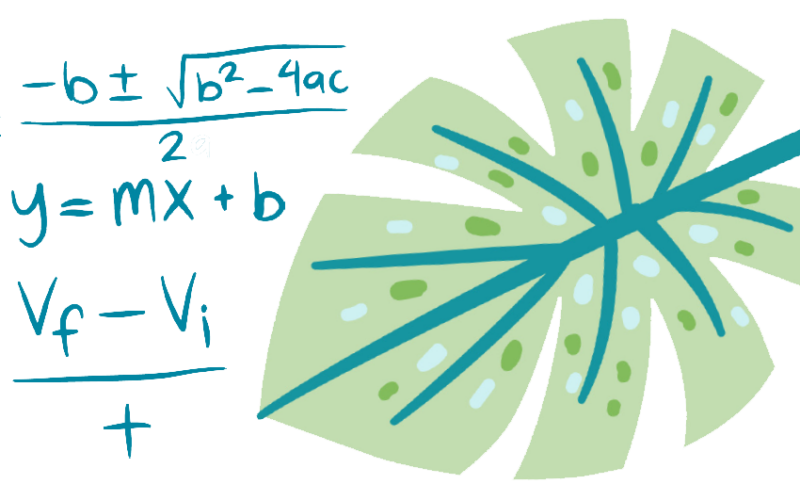CALM: The Way Math Should Be

by Heidi Schuler-Jones
Adult education can be overwhelming for new teachers, especially math.
Many adult education teachers learn quickly that we don’t choose our environment. We teach whatever is needed to whomever shows up at whatever level they are that day using whatever patchwork of materials are available in the shared classroom space. Students usually need math instruction, so we select whatever book we have the most copies of, began with chapter one, and work from there as far as we can, hoping we will not have to teach something that has never really made sense to us. If we encounter unfamiliar topics, we find online videos to learn what we need to teach our students. Sound familiar?
The challenge of teaching math from cover-to-cover is that it makes math feel like a series of discrete topics—disconnected and unrelated. We think we must begin with whole numbers long before algebra can be taught. If multiplication tables are not mastered, then we delay teaching fractions and spend our precious direct instruction time trying to get students to memorize facts. It’s a cycle of repeating instruction the way we learned and the way our students struggled to learn the first time— but that’s what we know and what we see in most math materials.
Teaching math and numeracy concepts can help.
In 2018, the Adult Numeracy Center (ANC) at TERC in Cambridge, Massachusetts set out to address these issues by developing a comprehensive math curriculum that would become the Curriculum for Adults Learning Math (CALM). Through a grant from Massachusetts’ Adult and Community Learning Services, the ANC designed a math curriculum to help students reach Educational Functioning Level gains, college and career readiness, and WIOA compliance, yet be flexible enough to teach in multilevel classes and programs with inconsistent attendance. The experienced development team followed the mantra “slow down to speed up,” i.e., by slowing instruction and ensuring students first have a solid mathematical foundation, they speed up and progress further toward their educational goals in the long run.
The team focused on conceptual understanding as a means of changing habits of mind and facilitating a growth mindset. “Conceptual understanding is defined as “an integrated and functional grasp of mathematical ideas” (Kilpatrick et al., 2001, p. 118). These two aspects of conceptual understanding—integrated and functional—frame the ability to think and act numerately and effectively. “Across the frameworks, this is described with words like ‘meaning-making,’ ‘relationships,’’ ‘model,’ and ‘understanding’” (Ginsberg et al., 2006, p. 22). From prior work with National Science Foundation grant projects like EMPower and Teachers Investigating Adult Numeracy, the team knew that through conceptual understanding and problem-solving, students learn to transfer knowledge from the classroom to life. As students realize there are many strategies for tackling a math situation, they build procedural fluency—which means that, according to the College and Career Readiness Standards for Adult Education (CCRSAE), “Students with a solid conceptual understanding see mathematics as more than just a set of procedures. They know more than ‘how to get the answer’ and can employ concepts from several perspectives” (Pimentel, 2013, p. 45).
Experiencing the coherence of math and connecting it to the lives of adults.
The other unique design of CALM is the intentional organization that highlights the rich connections between math content. The Scope and Sequence, which offers an overview of the 22 units, shows a coherent mathematics curriculum aligned to strategically selected standards from Level B (to ensure a strong foundation in number and operation sense) through Level E of the CCRSAE. This variety of standards prepares students for high school equivalency and lays the foundation for college and career readiness. This curriculum is designed to prepare adult learners to be college-ready and demonstrate that readiness on an exam. However, we know that students who need a stronger understanding of concepts will benefit from more time in the earliest units to think critically and connect math concepts.
Each unit closes with an application of that unit’s key ideas to a workforce-related project. Unlike typical curricula, multiple math concepts appear at the same time with one essential topic anchoring the lessons. For example, Unit 2 focuses on proportional reasoning in the context of t-shirt production and incorporates three levels of standards from measurement, proportional reasoning, and scale drawings.
Likewise, we intentionally introduced concepts considered higher-level at lower levels. Students won’t master them by the end of a unit. Rather, these concepts intentionally grow across units to deepen and connect ideas. For example, we introduce proportional reasoning, a big idea considered the gateway to learning abstract algebra, in Unit 1 with an emphasis on a real-world application of scale drawings. In Unit 4, students reason proportionally with percents as rates and in Unit 18 with function tables. Overall, students see the coherence of the math domains and explore real-world contexts in which they co-exist. Collaborative learning opportunities challenge the idea of what math class has been and foster new expectations for what math has to offer.
Interested in learning more? Download sample lessons, unit overviews, an overview of the scope and sequence, and progressions, or watch students and educators from the CALM pilot share their experiences. https://www.terc.edu/calm/
References
Ginsburg, L., Manly, M., & Schmitt, M. J. (2006). The components of numeracy. Harvard Graduate School of Education, National Center for the Study of Adult Learning and Literacy. https://www.ncsall.net/fileadmin/resources/research/op_numeracy.pdf
Kilpatrick, J., Swafford, J., & Findell, B. (Eds.). (2001). Adding it up: Helping children learn mathematics. National Research Council, Mathematics Learning Study Committee, Center for Education, Division of Behavioral and Social Sciences and Education. National Academies Press. https://doi.org/10.17226/9822
Pimentel, S. (2013). College and career readiness standards for adult education. U.S. Department of Education, Office of Vocational and Adult Education. http://lincs.ed.gov/publications/pdf/CCRStandardsAdultEd.pdf
 Heidi Schuler-Jones is the Director of the Adult Numeracy Center at TERC. She has worked in adult education since 2006, spending much of that time expanding her understanding of tools and instructional strategies that make math meaningful, accessible, and fun for adult learners. She manages the SABES Mathematics and Adult Numeracy Curriculum & Instruction PD Center, oversees updates, research, and teacher support for the EMPower math series, and continues to facilitate professional development such as the Adults Reaching Algebra Readiness (AR)^2 institutes. At SABES, she was the lead developer of the Curriculum for Adults Learning Math (CALM). She is the president of the Adult Numeracy Network.
Heidi Schuler-Jones is the Director of the Adult Numeracy Center at TERC. She has worked in adult education since 2006, spending much of that time expanding her understanding of tools and instructional strategies that make math meaningful, accessible, and fun for adult learners. She manages the SABES Mathematics and Adult Numeracy Curriculum & Instruction PD Center, oversees updates, research, and teacher support for the EMPower math series, and continues to facilitate professional development such as the Adults Reaching Algebra Readiness (AR)^2 institutes. At SABES, she was the lead developer of the Curriculum for Adults Learning Math (CALM). She is the president of the Adult Numeracy Network.